Serviços Personalizados
Journal
Artigo
Indicadores
-
 Citado por SciELO
Citado por SciELO -
 Acessos
Acessos
Links relacionados
-
 Citado por Google
Citado por Google -
 Similares em
SciELO
Similares em
SciELO -
 Similares em Google
Similares em Google
Compartilhar
Ciencia y Tecnología Agropecuaria
versão impressa ISSN 0122-8706versão On-line ISSN 2500-5308
Cienc. Tecnol. Agropecuaria vol.20 no.3 Mosquera set./dez. 2019 Epub 10-Set-2019
https://doi.org/10.21930/rcta.vol20num3art:1591
Manejo de sistemas productivos
Effect of nitrogen-sulfur fertilization on yield and quality of three corn genotypes differing in endosperm texture
1Profesora Asociada, Universidad Central de Venezuela, Facultad de Agronomía. Maracay, Venezuela.
2Investigador PhD, Corporación Colombiana de Investigación Agropecuaria (AGROSAVIA), CI Tibaitatá. Mosquera, Colombia.
3Estudiante de Agronomía, Universidad Central de Venezuela, Facultad de Agronomía, Instituto de Agronomía. Maracay, Venezuela.
4Corporación Colombiana de Investigación Agropecuaria [AGROSAVIA]
To establish the effect of nitrogen-sulfur fertilization on yield and corn quality, an experiment was carried out at the peasant settlement of Arenales, Aragua state, Venezuela (10°06'17'' N, 67°35'44''W). The experimental design used was a split-plots with four replicates; three hybrids differing in endosperm texture were arranged on the main plots: DK-5632 (flint), DK-440 (semi-flint) and DK-5277 (semident), and on secondary plots, three levels of nitrogen (0, 100 and 200 kg/ha) and two levels of sulfur (0 and 50 kg/ha). The variables measured were the yield, the weight of 1000 grains (W1000G), grains per square meter (G/m2), hectoliter weight (HW), flotation index (FI), grain hardness (GH) and crude protein (CP). All corn genotypes increased their yield, W1000G and G/m2 significantly with the level of fertilization N200S50. Genotype DK-5277 reached the highest yield, while DK-5632 and DK-440 obtained higher values of HW compared to those achieved by DK-5277, as well as a lower FI, with significant differences at p ≤ 0.05. The level of fertilization N200S50 allowed a significant decrease of the FI values in all corn genotypes. Nitrogen-sulfur fertilization increased in more than 100 % the GH of DK-5277. The FI showed a negative and significant association with HW, while a positive and highly significant correlation was found between W1000G and yield. For all hybrids, CP was positive and significantly associated with yield and positive and highly significant with W1000G and HW.
Keywords crop yield; fertilizer application; nitrogen; sulphur; Zea mays
Para conocer el efecto de la fertilización nitro-azufrada sobre rendimiento y calidad de maíz, se realizó un experimento en el Asentamiento Campesino Arenales, estado Aragua, Venezuela (10°06'17'' N y 67°35'44'' O). El diseño utilizado fue parcelas divididas con cuatro repeticiones; en las parcelas principales se consideraron tres híbridos de diferentes texturas de endospermo: DK-5632 (córneo), DK-440 (semicórneo) y DK-5277 (semidentado), y en las secundarias, tres niveles de N (0, 100 y 200 kg/ha) y dos niveles de S (0 y 50 kg/ha). Las variables medidas fueron rendimiento (rend), peso de mil granos (P1000G), granos por metro cuadrado (G/m2), peso hectolítrico (ph), índice de flotación (if), dureza (d) y proteína cruda (pc). Los genotipos aumentaron significativamente rend, P1000G y G/m2 con el nivel de fertilización N200 S50 . DK-5277 alcanzó valores mayores de rend mientras que DK-5632 y DK-440 obtuvieron valores más altos de ph y menores de if, con diferencias significativas (p ≤ 0,05). El nivel de fertilización N200 S50 disminuyó significativamente el if en todos los genotipos. La fertilización nitroazufrada aumentó más de 100 % la D del DK-5277. El if se asoció de manera negativa y altamente significativa con el ph, mientras que P1000G y rend presentaron correlación positiva y altamente significativa. La pc se asoció positiva y significativamente con el rend, y de forma positiva y altamente significativa con P1000G y ph.
Palabras clave aplicación de abonos; azufre; nitrógeno; rendimiento de cultivos; Zea mays
Introduction
Nitrogen fertilization in corn cultivation is one of the most critical aspects of its agronomic management and has been a decisive factor in obtaining high yields worldwide. Nitrogen is considered as the main element for plant production because it is, in most situations, the factor that limits productivity (Capurro, Fiorito, González, & Pagani, 2002; Kappes, Orivaldo, & Da Costa, 2013). On the other hand, sulfur is currently an essential nutrient, whose deficiency is frequently reported in various works (Ferraris et al., 2007; Sakal, Singh, Sinha, & Ismail, 2000; Weil, & Mughogho, 2000).
In Venezuela, there is little information regarding the response of corn to sulfur fertilization. However, the probability that the productivity of the crop is affected by this deficiency is high, since Venezuelan soils used for corn cropping mostly meet conditions that favor the deficiency of this element. These conditions include the progressive reduction in organic matter content, low turnover, and insufficient nutrient replenishment (Caamaño & Melgar, 1998; Reussi, Echeverría, & Sainz, 2006).
Conversely, these two nutrients have proven to be fundamental in the improvement of the physical and nutritional quality of corn grains. The availability of N affects grain yield and quality (Governatori & Uhart, 1997; Vázquez, Arellano, & Santiago, 2015). On the other hand, sulfur, is a constituent of amino acids such as cysteine and methionine, so the application of sulfur fertilizers increases the protein content of the grain and affects the texture of the endosperm (Pedrol, Salvagiotti, Castellarín, Rosso, & Vernizzi, 1999; Salvagiotti, Castellarin, Miralles, & Pedrol, 2009). This modifies positively quality parameters such as weight in hectolitres, flotation index, and hardness (Barrios, Basso, & García, 2016). The quality of corn grains is a feature determined by factors such as climate and soil, as well as by factors that we can manipulate to improve and maintain yield and quality levels, among which fertilization is found. The aim of this work was to evaluate the effect of fertilization with N and S on yield and some of its components, and grain quality aspects of three corn genotypes with different endosperm textures.
Materials and methods
The field trial was carried out at the Peasant Settlement of Arenales, Plot # 18, Zamora District, Aragua State, Venezuela (10°06'17'' N and 67°35'44''W), with average annual precipitation and temperature values of 820 mm and 26.5 °C, respectively (Climatic and Edaphic Station of Santa Cruz, Aragua State, Venezuela). The physicochemical characteristics of the soil where the trial was carried out are presented in table 1. Three corn genotypes with different endosperm textures constitute the evaluated plant material: flint (DK-5632), semi-flint (DK-440) and semi dent (DK-5277). The experimental unit consisted of plots of 3.6 × 4.0 m2 with four rows of 4 m long separated by 0.9 m; the distance between plants was 0.20 m.
The source of nitrogen used was urea (46 % of N), and its application was carried out in two fractions: the first during the sowing, and the second 25 days after sowing (das) when the crop had 6 to 8 leaves (Ritchie, Hanway, & Benson, 1993). Calcium sulfate was used as a source of sulfur (20 % of S, 16 % of Ca) and it was applied during sowing; both sources were incorporated at a distance of 5 cm below and next to the seed to avoid phytotoxic effects (Ciampitti, Fontaneto, Micucci, & García, 2006). A split-plot design with four repetitions was used. The main plots were the corn genotypes, and the secondary plots were the combination of fertilizer levels, which consisted of three levels of nitrogen: 0, 100 and 200 kg/ha, and two levels of sulfur: 0 and 50 kg/ha. These were designated as N0S0, N100,S0, N200S0, N0S50N100S50 and N200S50. Chemical and manual control of weeds, insect pests, and diseases were carried out, and a 5 mm water sheet was applied daily for supplementary irrigation by gravity (furrows).
Table 1. Physicochemical characteristics of the soil used in this studyC: Clay, CL: clay loam, OM: organic matter
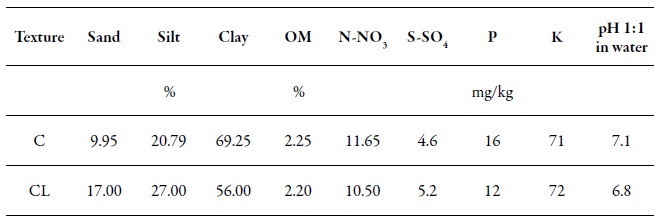
Source: General Soil Laboratory, Instituto de Edafología Fagro-UCV, Maracay, Venezuela.
Productivity variables
The productivity variables analyzed in this research are the following:
Yield. In each experimental unit, 10 m2 were harvested manually; grain moisture was established in physiological maturity, whose records were used to express the yield at 12% moisture content of the grain.
Weight of 1000 grains (W1000G). In each genotype 100 grains obtained at random were weighed in a Sartorius Basic microbalance with a sensitivity of 0.001 g; subsequently, the result in grams was multiplied by 10.
Number of grains per square meter (G/m2). The number of G/m2 was estimated by the quotient between the yield (on dry basis) and the individual weight of the grain. This was established with the average of two samples of 200 grains each, dried in a forced air oven for ten days.
Grain quality variables
The grain quality variables measured in this study are presented below:
Hectoliter weight (hw). Hectoliter weight was estimated according to method 55-10 (Approved Methods of the American Association of Cereal Chemists [aacc], 1998) and expressed in kg/hL.
Flotation index (fi). The FI was obtained from 100 healthy grains placed in an Erlenmeyer of 250 mL, containing 170 mL of a mixture of kerosene-carbon tetrachloride (d = 1.305 at 25 °C). After a brief agitation with a glass rod, the grains that floated were counted. The flotation index was calculated as the percentage of grains that floated (Robutti, Borrás, González, Torres, & De Greef, 2002).
Grain hardness (gh). Grain hardness was determined by increasing it fivefold in a 10-grain sample, carrying out a penetration resistance test measured with a texture analyzer (TAXT2) provided with a conical punch (30° angle), at a speed of 0.5 mm/s, and a penetration distance of 2 mm. The hardness of the grain was reported in kg-f.
Crude protein (cp). Crude protein was established through the Kjeldahl method (AACC, 1998) and expressed in percentage.
Statistical analysis
The data were analyzed with the statistical program Statistix 8.0. An analysis of variance was carried out according to the experimental design used, and the means obtained in the combinations of the different levels of fertilization were compared through Tukey's multiple comparisons test. Correlations were also made between the variables measured using Pearson´s method.
Results and discussion
Yield and its components
The hybrid × fertilization interaction was statistically significant (p≤ 0.001) for all the measured variables; this behavior is related to the yield potential of each hybrid and the type of endosperm, which determined the response of the materials evaluated. In table 2 is shown the effect of the fertilization with nitrogen and sulfur on the yield and its components for each corn genotype evaluated. The DK-5277 hybrid with semi-dent (soft) endosperm obtained the highest yields (10,274 kg/ha) when the fertilization level applied was N200S50, with an increase of 42.2% compared to the control, and of 39.8% and 38.7% compared to the flint and semi-flint genotypes, respectively.
Commonly, higher yields are observed in corn with soft or semi-dent textures compared to hard or flint textures, which may be determined by a decrease in the protein content in the grain (Ciampitti & Vyn, 2013; Salvagiotti, Castellarín, Ferragutti, Dignani, & Pedrol, 2010). On the other hand, Ferragutti, Castellarín, and Salvagiotti (2016) also obtained a greater response in yield in a hybrid with semi-dent texture compared to one with a flint texture, when they evaluated the nutritional requirements of these hybrids. All the genotypes evaluated reached the highest yields when they were fertilized with N200S50, with statistically significant differences between fertilization levels compared to the control (p ≤ 0.05).
Capurro et al. (2002) found that the yield response of corn to the aggregate of S was significant with doses of N higher than 60 kg/ha and higher to increasing doses of N; besides, these showed that there is a significant N*S interaction. Conversely, corn genotypes with high yield potential have very high nutrient requirements, so their response is greater at higher doses of N (Salvagiotti et al., 2010). Similarly, the interaction between nutrients can increase the efficiency of the applied fertilizer and improve the utilization of N by the crop (Stewart, 2007).
Other cereals have also experienced similar responses to the application of S; Hoffman, Fassana, Mazzilli, Berger, and Ernst (2016) found that in wheat, the addition of N in the presence of S increased the absorbed amounts of N. The response of the genetic materials to S of this trial is related to the low mean contents of organic matter and the reduced levels of this nutrient in the soil (table 1). Furthermore, also to the long agricultural history of the area without contributions of sulfur fertilizers, which is the determining cause of S deficiency in soils (Pagani, Echeverría, & Sainz, 2009).
Regarding the variable W1000G, statistically significant differences (p ≤0.05) were observed between the levels of fertilization compared to the control (table 2) for all genotypes, detecting response to fertilization with N and S. All materials evaluated reached the highest W1000G with the application of 200 and 50 kg/ha of N and S, respectively; with this fertilization level the values obtained were significantly different (p ≤ 0.05) compared to the values found in the rest of the fertilization levels applied.
The increase of the W1000G by increasing the dose of N generally depends on the relationship between the weight of the grain and the growth of the plant during the filling of the grains, and this is why in the control treatment, this increase was limited by the smaller amount of assimilates (Amin, 2011). In this case, the addition of S improves both the grain yield and the W1000G with the highest dose of N, even though this variable is not a component that is as directly associated with the yield as the number of G/m2 (Pérez, 2015). These results are indicative that the characteristics of each genotype and their ability to remobilize assimilates towards the grain can favor the yield and its components.
Regarding the number of G/m2, considering the factor most closely related to variations in yield (Capurro et al., 2002; Muchow, 1998), the highest values were obtained with the fertilization level of N200S50 for all hybrids, with significant statistical differences (p ≤ 0. 05) between fertilization levels compared to the control. These results indicate that the increase in the number of G/m2 in response affects the individual weight and quality of the to the addition of S, was a decisive factor in yield grains (Pagani et al., 2009). Ferragutti et al. (2016) increase in the corn genotypes evaluated, and that obtained a similar response when they evaluated fertilization with N and, to a lesser extent with S, fertilization with nitrogen and sulfur in corn modify the supply of assimilates and nutrients, and hybrids with flint and semi-dent textures.
Table 2. Effect of nitrogen-sulfur fertilization on the yield, the weight of a thousand grains and the number of grains per square meter, of three corn hybrids with different endosperm textures
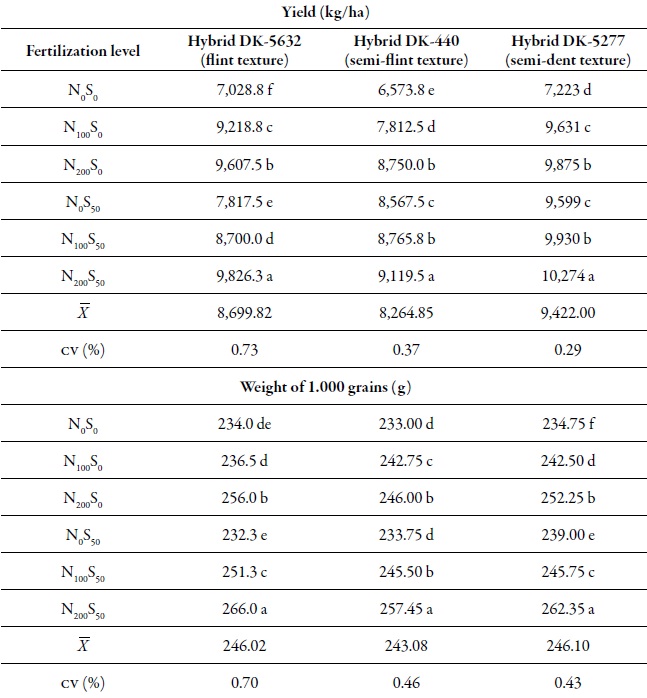
Note.Different letters within a column indicate significant differences (p ≤ 0.05) according to Tukey's multiple comparisons test.
Source: Elaborated by the authors
Table 2. (cont.) Effect of nitrogen-sulfur fertilization on the yield, the weight of a thousand grains and the number of grains per square meter, of three corn hybrids with different endosperm textures.
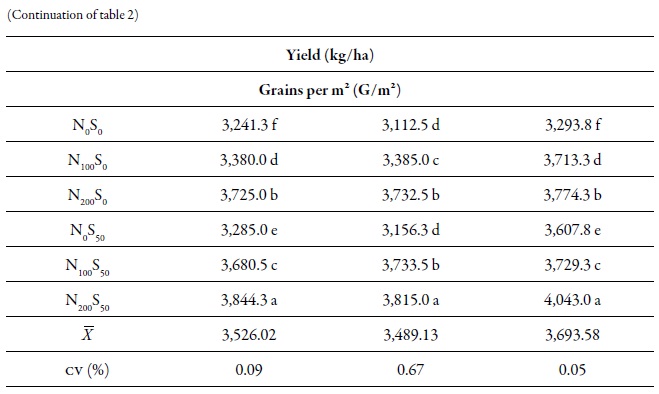
Note.Different letters within a column indicate significant differences (p ≤ 0.05) according to Tukey's multiple comparisons test.
Source: Elaborated by the authors
Physical and nutritional quality of the grain
In table 3 is shown that the HW values showed significant differences (p ≤ 0.05) between the levels of fertilization compared to the control for all hybrids evaluated, which shows that the genotype x fertilization interaction significantly influenced the HW of the grains. In this study, the flint and semi-flint genotypes (DK-5632 and DK-440) obtained higher HW values compared to the semi-dent hybrid, because grains with flint endosperm are denser and heavier than those with a soft endosperm. This confirms that when there is higher endosperm hardness, the HW is also higher. Authors as Barrios et al. (2016) reported similar results.
In general, the HW is a quality parameter that responds to nitrogen fertilization and, taking into consideration that the absorption of N is favored when the crop is fertilized with S (Salvagiotti et al., 2009) the HW values reached were expected. On the other hand, even when the quality of the flint genotype was higher compared to the HW, the yield was lower in comparison with the hybrid of soft or semi-dent texture (table 2). This behavior is commonly observed in the field since the dent, and semi-dent corn textures have higher yield potential, a product of the genetic improvement (Calderone, Torres, Papucci, Cruciani, & González, 2008).
The semi-dent hybrid DK-5277 also showed more significant response in the HW compared to the other two hybrids with the application of N200S50, if we consider that this genotype experienced an increase of 8.9% compared to the control and in comparison with the increases experienced by the hybrids DK-5632 and DK-440 (6.4 % and 7.7 %, respectively). These results indicate a greater efficiency in the use of nitrogen with the addition of 50 kg/ha of sulfur and represents an improvement in the grain quality of this genotype due to the increase in HW values. Since S is found in proteins as an amino acid component, among others methionine and cystine, the application of sulfur fertilizers could have important effects not only on the increase in protein content, but also on changes in texture and density of the endosperm, increasing the resistance to grain breakage (Cruciani, González, Papucci, & Pedrol, 2014).
Nonetheless, the FI represents one of the most important indicators of hardness for the dry milling process (Ferragutti, Salvagiotti, & Castellarín, 2012). In this trial, significant differences were obtained (p ≤ 0.05) for the FI between the levels of fertilization compared to the control for each of the genotypes evaluated (table 3), where the hybrids of hard and semi-hard texture, i.e., DK-5632 and DK-440, showed lower FI values. In this experiment, the application of the fertilization level N200S50 allowed a significant decrease in the FI values, which is an indication of an improvement in grain quality in terms of hardness (Zepeda et al., 2009). This tendency occurred primarily in the case of the semi-dent hybrid DK-5277. Considering studies that have shown that a greater absorption of N occurs in crops fertilized with S (Salvagiotti et al., 2009), these results corroborate that the nitrogensulfur fertilization strategy has an important effect on the texture of the endosperm, increasing the density of the grain through the increase of the proportion of zeins and glutelins in the flint endosperm (Barrios et al., 2016; Tsai, Dwerkat, Huber, & Warren, 1992).
In relation to the hardness of the endosperm, this is a property of the grain associated with a higher density and vitrosity of the flint endosperm, factors that depend on the union between starch and proteins, especially zeins, a fraction abundant in sulfur amino acids (Cirilo, Actis, Andrade, & Valentinuz, 2011). In this study, significant differences (p ≤ 0.05) between the levels of fertilization compared to the control for the hardness test were obtained for all the evaluated genotypes. Genotype DK-5277 of soft endosperm reached lower values compared to the flint and semi-flint genotypes, as expected, as in the flint fraction of the endosperm the starch and the protein are strongly bound, and in the mealy fraction the link is weaker, although fertilization with N and S allowed a much more evident response in this genotype. This is because the increase concerning the control was more than 100 % compared to the values of 15.99 % and 20.18 % obtained with the flint and semi-flint hybrids, respectively. The improvement of the hardness test values in response to nitrogen fertilization in all hybrids evaluated corroborates that timely nutrition with S and N, which ensures adequate flow of these nutrients to the grains, would favor its hardness by increasing the concentration of both elements (Cirilo et al., 2011).
Regarding the CP content, the means obtained with the fertilization level N200S50 for all hybrids differed significantly with those of the rest of the fertilization levels and compared to the control (p ≤ 0.05). These results confirm that the protein content increases by an adequate substitution of N and S, and that this increase positively influences grain density, reducing the susceptibility to cracking as a consequence of the higher zein content and the higher flint/floury endosperm ratio (Cirilo et al., 2011; Cruciani et al., 2014). On the other hand, gamma and beta zeins also require S for their synthesis, due to the presence of sulfur amino acids in their composition (Wu & Messing, 2010), which would explain the response to this fertilization strategy.
The correlation between the measured variables is presented in table 4. For the three genotypes, CP was positively and significantly associated with yields and GH, and positively and highly significant with HW and W1000G, while the FI showed a negative and highly significant correlation. The fertilization strategies evaluated in this trial allowed an increase in the physical quality of the grain through a decrease in the FI of each hybrid. The HW was associated in a negative and highly significant way with the FI, while the W1000G and the yield were associated in a positive and highly significant way.
Table 3. Effect of nitrogen-sulfur fertilization on the hectoliter weight, the flotation index, the grain hardness and the crude protein content of three corn hybrids with different endosperm textures
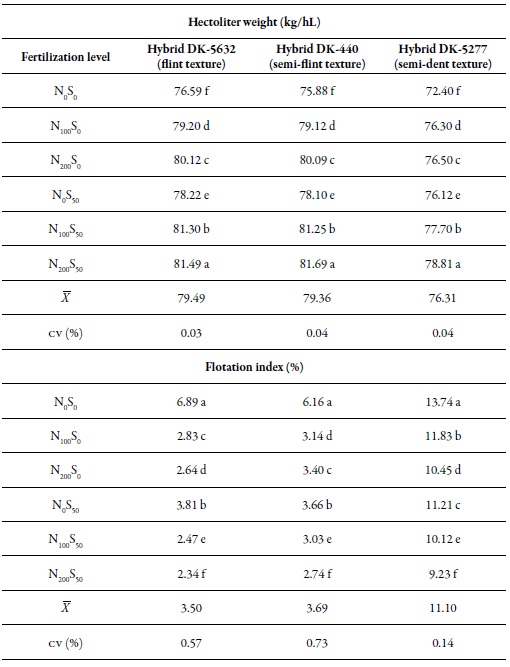
Note.Different letters within a column indicate significant differences (p≤0.05) according to Tukey's multiple comparisons test
Source: Elaborated by the authors
Table 3. Effect of nitrogen-sulfur fertilization...(Cont)
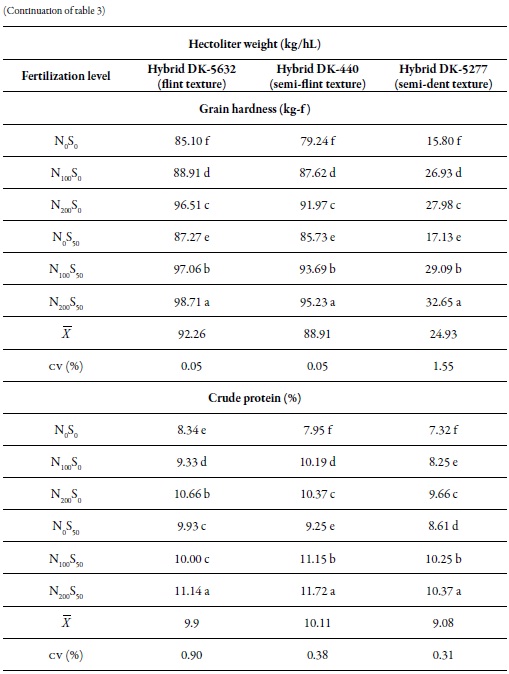
Note.Different letters within a column indicate significant differences (p≤0.05) according to Tukey's multiple comparisons test
Source: Elaborated by the authors
Table 4. Coefficients of linear correlation between grain hardness (GH), grains per square meter (G/m2), flotation index (FI), hectoliter weight (HW), the weight of 1.000 grains (W1000G), percentage of crude protein (CP) and yield, in three corn hybrids with different endosperm textures
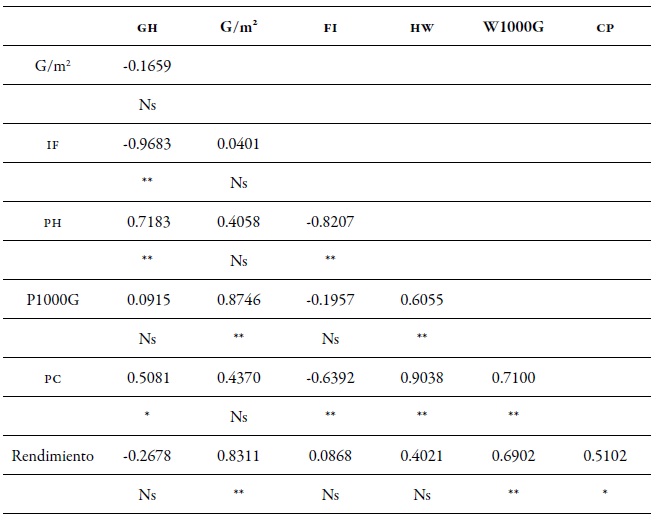
Source: Elaborated by the authors
Conclusions
The interaction between the genotype and the fertilization strategy influences all the variables measured in this study. All hybrids reach the highest yields when they are fertilized with the level of fertilization of N200S50. The soft endosperm hybrid showed the highest yields. The fertilization with N and S for all hybrids evaluated generates an increase in the percentage of proteins, which produces effects on the texture of the grain, increases its density and weight, and decreases its flotation index. The application of N200S50 allows reducing the flotation index values significantly in all hybrids. The results obtained for the measured variables indicate a greater efficiency in the use of N with the addition of 50 kg/ha of S. The yield and the weight of one-thousand grains correlate in a positive and highly significant way, while the crude protein content is positively and significantly associated with the yield and the grain hardness. Moreover, also in a positive and highly significant way with the hectoliter weight and the weight of one-thousand grains. Further, the hectoliter weight shows a negative and highly significant correlation with the flotation index.
Acknowledgments
The authors wish to thank Consejo de Desarrollo Científico y Humanístico [Council of Scientific and Humanistic Development] of Universidad Central de Venezuela, for financing this study through the project CDCH-PG-01-8157-2013.
REFERENCES
American Association of Cereal Chemists (AACC). (1998). Approved Methods. St. Paul, EE. UU. autor. [ Links ]
Amin, M. E. (2011). Effect of different nitrogen sources on growth, yield and quality of fodder maize (Zea mays L.). Journal of the Saudi Society of Agricultural Science, 10(1), 17-23. doi:10.1016/j.jssas.2010.06.003. [ Links ]
Barrios, M., Basso, C., & García, J. (2016). Efecto de la fertilización nitrogenada sobre el rendimiento y la calidad de seis híbridos comerciales de maíz en Venezuela. Revista de la Facultad de Agronomía (UCV), 42(1), 15-23. [ Links ]
Caamaño, A., & Melgar, R. J. (1998). Fertilización con fósforo, nitrógeno y azufre en ambientes de alta productividad. Revista Tecnología Agropecuaria, 2(5), 11-14. [ Links ]
Calderone, M., Torres, J., Papucci, S., Cruciani, M., & González, A. (2008). Influencia del sistema de labranza y la fertilización nitrogenada sobre el rendimiento y la calidad de maíz (Zea mays L.). Revista Agro Mensajes, 56, 26-27. Recuperado de https://www.rephip.unr.edu.ar/bitstream/handle/2133/1255/Labranza_fertilizacion_maiz.pdf?sequence=1 [ Links ]
Capurro, J., Fiorito, C., González, M., & Pagani, R. (2002). Fertilización del cultivo de maíz en Cañada de Gómez. Campaña 2001/02. Revista Informaciones Agronómicas del Cono Sur, 15, 81-84. [ Links ]
Ciampitti, I. A., Fontanetto, H., Micucci, F., & García, F. O. (2006). Manejo y ubicación del fertilizante junto a la semilla: Efectos Fitotóxicos. Informaciones Agronómicas, 31(10), 1-8. Recuperado de https://www.lacs.ipni.net/ipniweb/region/lacs.nsf/0/485FEB6666B9B7BC03257967004AA42C/$FILE/AA%2010.pdf [ Links ]
Ciampitti, I. A., & Vyn, T. J. (2013). Grain nitrogen source changes over time in maize: A review. Crop Science, 53(2), 366-377. doi:10.2135/cropsci2012.07.0439. [ Links ]
Cirilo, A. G., Actis, M., Andrade, F. H., & Valentinuz, O. R. (2011). Crop management affects dry-milling quality of flint maize kernels. Field Crops Research, 122(2), 140-150. doi:10.1016/j.fcr.2011.03.007. [ Links ]
Cruciani, M. A., González, A., Papucci, S., & Pedrol, H. (2014). Fertilización nitro azufrada: rendimiento y calidad en híbridos de maíz. Ciencia Agronómica, 22 (13), 21-25. [ Links ]
Ferragutti, F., Salvagiotti, F., & Castellarín, J. (2012). Rendimiento y calidad de maíz según estrategias de fertilización con nitrógeno y azufre. Boletín infoINTA Santa Fe Sur, 13, 41-43. Recuperado de https://www.inta.gob.ar/sites/default/files/script-tmp-rendimiento-calidadmaz-segn-estrategias-fertilizacin.pdf [ Links ]
Ferragutti, F., Castellarín, J., & Salvagiotti, F. (2016). Momento de fertilización con nitrógeno y azufre y requerimientos nutricionales en maíces flint y semidentados. Artículo técnico Instituto Nacional Tecnología Agropecuaria. Simposio Fertilidad 2015, Nutriendo los Suelos para las Geraciones del Futuro, Buenos Aires, Argentina. Recuperado de https://www.engormix.com/agricultura/articulos/momentofertilizacion-con-nitrogeno-t32397.htm [ Links ]
Ferraris, G., Couretot, L., Mousegne, F, López de Sabando, M., Pontoni, R., & Sola, R. (2007). Evaluación de diferentes dosis y momentos de aplicación de nitrógeno y su interacción con el azufre utilizando fuentes líquidas en Maíz, en el norte de Buenos Aires. En Autor, Experiencias en fertilización y protección en el cultivo de maíz (pp. 136-146). Buenos Aires, Argentina: Cerban; Áreas de Desarrollo Rural EEA INTA Pergamino y General Villegas. [ Links ]
Governatori, S., & Uhart, S. (1997). Efecto de la disponibilidad del nitrógeno sobre la calidad física de los granos de cultivares de maíz liberados en diferentes épocas. Actas del VI Congreso Nacional de Maíz, 2, 46-53. [ Links ]
Hoffman, E., Fassana, N., Mazzili, S., Berger, A., & Emst, O. (2016). La productividad parcial de los nutrientes. La necesidad de incrementar la eficiencia de uso del Nitrógeno. Recuperado de https://www.engormix.com/agricultura/foros/productividad-parcial-nutrientesnecesidad-t40508/ [ Links ]
Kappes, C., Orivaldo, A., & Da Costa, J. (2013). Produtividade do milho em condições de diferentes manejos do solo e de doses de nitrogẽnio. Revista Brasileira de Ciẽncia do Solo, 37(5), 1310-1321. [ Links ]
Muchow, R. C. (1998). Nitrogen utilization efficiency in maize and grain sorghum. Field Crops Research, 56(1-2), 209-216. doi:10.1016/S0378-4290(97)00132-9 [ Links ]
Pagani, A., Echeverría, H., & Sainz, H. (2009). Respuesta a nitrógeno y azufre en el cultivo de maíz en diferentes ambientes de la Provincia de Buenos Aires. Ciencia del Suelo, 27(1), 21-29. [ Links ]
Pedrol, H., Salvagiotti, F., Castellarín, J., Rosso, O., & Vernizzi, A. (1999). Maíz: respuesta a la fertilización azufrada con diferentes niveles de nitrógeno y fósforo. Para Mejorar la Producción, 10, 51-56. [ Links ]
Pérez, G. (2015). Evaluación de cultivares de maíz campaña 2014-2015 en Bolívar. Bolívar, Argentina: Instituto Nacional Tecnología Agropecuaria (INTA). Recuperado de https://www.inta.gob.ar/sites/default/files/script-tmp-inta_bolvar_evaluacin_de_cultivares_de_maz_campaa_201.pdf [ Links ]
Reussi, N., Echeverría, H., & Sainz, H. (2006). Respuesta del cultivo de trigo al agregado de azufre en el sudeste bonaerense. Ciencia del Suelo, 24(1), 77-87. [ Links ]
Ritchie, S. W., Hanway, J., & Benson, G. (1993). How a corn plant develops. Iowa State University of Science and Technology. Cooperative Extension Service Ames, Iowa. Special Report N.° 48. Recuperado de https://www.s10.lite.msu.edu/res/msu/botonl/b_online/library/maize/www.ag.iastate.edu/departments/agronomy/corngrows.html [ Links ]
Robutti, J. L., Borrás, F. S., González, R. J., Torres, R. L., & De Greef, D. M. (2002). Endosperm properties and Extrusion cooking behavior of maize cultivars. Food Science and Technology, 35(8), 663-669. doi:10.1006/fstl.2002.0926. [ Links ]
Sakal, R., Singh, A. P., Sinha, R. B., & Ismail, M. (2000). Relative performance of some sulphur sources on sulphur nutrition of crops in calcareous soil. Annals of Agricultural Research, 21, 206-211. [ Links ]
Salvagiotti, F., Castellarín, J., Miralles, D., & Pedrol, H. (2009). Sulfur fertilization improves nitrogen use efficiency in wheat by increasing nitrogen uptake. Field Crop Research, 113, 170-177. [ Links ]
Salvagiotti, F., Castellarín, J., Ferragutti, F., Dignani, D., & Pedrol, H. (2010). Umbrales de respuesta a la fertilización nitrogenada en maíz y dosis óptimas económicas según potencial de producción. Para Mejorar la Producción, 44, 41-44. [ Links ]
Stewart, W. M. (2007). Consideraciones en el uso eficiente de nutrientes. Informaciones Agronómicas, 67, 1-7. [ Links ]
Tsai, C., Dweikat, I., Huber, D., & Warren, H. (1992). Interrelationship f nitrogen nutrition with maize (Zea mays) kernel yield, nitrogen use efficiency and kernel quality. Journal of the Science of Food and Agriculture, 58, 1-8. doi:10.1002/jsfa.2740580102 [ Links ]
Vázquez, G., Arellano, J., & Santiago, D. (2015). Rendimiento y calidad de grano y de tortilla de maíces híbridos de Valles Altos de México crecidos en riego y temporal. Revista Fitotecnia Mexicana, 38 (1), 75-83. Recuperado de https://www.scielo.org.mx/pdf/rfm/v38n1/v38n1a10.pdf [ Links ]
Weil, R. R., & Mughogho, S. K. (2000). Sulfur nutrition of maize in four regions of Malawi. Agronomy Journal, 92(4), 649-656. doi:10.2134/agronj2000.924649x [ Links ]
Wu, Y., & Messing, J. (2010). RNA Interference-mediated change in protein body morphology and seed opacity through loss of different zein proteins. Plant Physiology, 153(1), 337-347. doi:10.1104/pp.110.154690. [ Links ]
Zepeda, R., Carballo, A., Muñoz, A., Mejía, A., Figueroa, B., Hernández, C. (2009). Proteína, triptófano y componentes estructurales del grano en híbridos de maíz (Zea mays L.) producidos bajo fertirrigación. Agrociencia, 43(2), 143-152. [ Links ]
Received: June 29, 2018; Accepted: April 10, 2019











 texto em
texto em 



